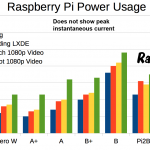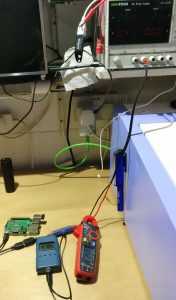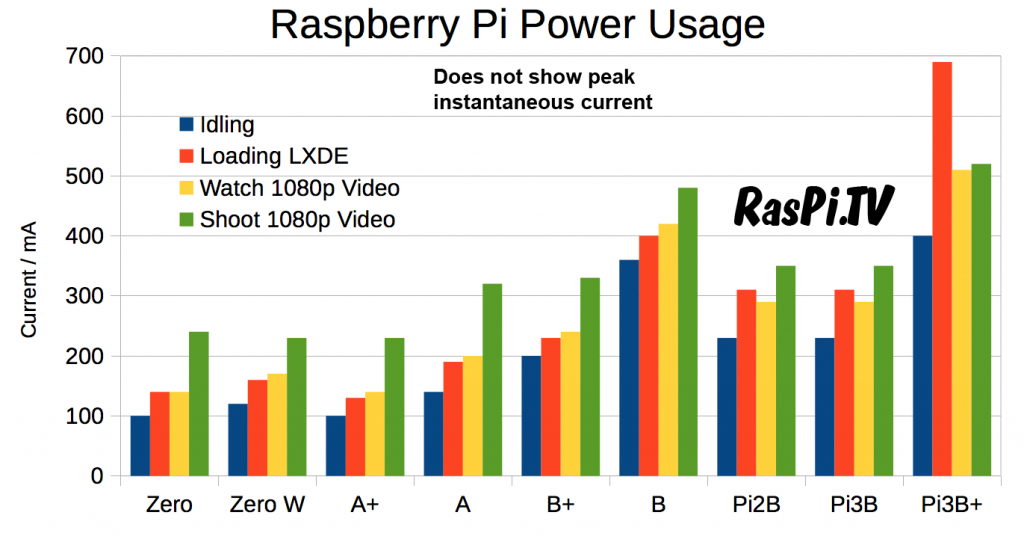
Since the original Pi came out I’ve been interested in how much power it consumes. It’s become something of a launch week tradition to publish a new chart and some data. So much so that several people ask for it on launch day. This time the first was within 7 minutes of launch, which is a new record…
Did you test the energy consumption?
— El Datavizzardo (@datavizzard) March 14, 2018
Why?
The main reason I do this is that, if you are running a Pi on batteries, you need to be able to know how long it will run for. So I don’t go in for complicated benchmarking tests (although arguably perhaps I should, now that the CPUs are getting more powerful and hungrier) but a straightforward batch of tests that I’ve always used. It gives you an idea and enables you to work out your power budget.
How?
With just an HDMI screen and a USB keyboard/mouse dongle connected, the Pi is powered using my bench power supply at 5.2V (supply current limit = 3 Amps) wired, via the eMeter’s calibrated 20 Amp shunt, to the uUSB power input on the Pi.
Current and voltage are measured using my eMeter (also used my clamp meter to confirm this time) and calibrated shunt whilst performing four different activities. “Shooting video” is done without saving the video output to the SD card. Watching video is done with a 1080p video on the SD card. The rest is self-explanatory. The camera module is unplugged for all but the shooting video test. The Pi3B+ was connected to wifi, but no bluetooth devices were in use.
Understanding the Limitations
It’s important to understand the limitations of any equipment, tests and results. Comparing the readouts on the bench power supply, clamp meter and taking the actual data readings from the eMeter gives a reasonable degree of confidence in the results (when they agree, which they did).
The eMeter gives time-averaged readings (updated several times per second) to two decimal places of an Amp, which is good enough for our purposes. It won’t give a true picture of peak instantaneous current e.g. on power-up of the ARM cores from idle. This matters only when selecting a PSU to run your Pi, and you already have the official recommendations of a 2.5 Amp PSU for that. What we’re interested in is power usage over time, so you can work out what size battery pack or solar panel you will need.
I’ve never done power tests while using ethernet. But the new Gigabit ethernet chip definitely chews through more power than the previous Pi models (even when not in use). At some point I will consider adding this data to the chart/table, but not today. It would require measurement of “all of the Pis” which I haven’t got time to do right now – and you want your data NOW!
Results
Commentary
The thing that jumps out at you if you compare 3B+ with 3B is that it uses at least 170 mA more current – even at idle. This is due to the new Gigabit ethernet chip. I believe there will be a facility to switch this off if not used (at some point).
This seems to account for most of the differences except for while under CPU load. Whilst watching or shooting video, the GPU is handling most of the work, and this is unchanged on the new chip. So it’s not really surprising to see only small differences if you strip out the effect of the new LAN7515 chip.
Where we DO see a significant difference is in the loading of LXDE while under CPU load. You can see that this is significantly higher than with the Pi3B. It’s probably loading faster, but you don’t get ‘owt for n’owt. Faster processing takes more power, and that’s what we can see in the chart.
TL;DR
Raspberry Pi 3B+ uses at least 170 mA more than its older sibling the Pi3B, but can use significantly more when the ARM CPUs are being driven hard.



Wow, interesting figures, thanks Alex!
If you *do* ever get round to re-testing all the Pis (which is of course entirely up to you), it might also be interesting to measure the current draw during your Scrabble word speed-test, so that we could then multiply Voltage * Current * Time to get an idea of the total energy that each Pi uses to run the same processing task ?
Yes that’s a good idea Andrew.
And the heat? Where goes all the heat generated?
It disappears into the ether(net) ;p
Maybe we should just keep using heat sinks!!!
I wonder what they’ve done to the LXDE loading to make it suck that much power up… Thanks, as always, for the figures! As you say, you don’t get owt for n’owt. Zero is still the route to go for low power, then!
It’s probably something to do with the new PMU, and the improvements to the power handling of the ARM cores on the new silicon just showing a larger more noticeable peak on the eMeter. So really I think it’s just the faster processing causing it.
It would be interesting to compare the greater power draw vs presumably lower processing time to see the overall change in power consumption.
Also, thanks for doing this, it’s a really useful resource!
Yup, that’s exactly what I already suggested above ;)
It’s still frugal!
Oh yeah. For mains use it’s pretty trivial.
I read that a 2,5A power source is recommended for 3B+, but I see that even a power hungry operation (like loading the desktop) is far less than 1A. Will it be ok to run it, mostly as a server (low load), with a 1,2A hub?
The answer is “I don’t know. Try it and see.” I went to some length to explain the limitations of my measurements. The fact is that you need a capable PSU because there will be times when the ARM wants a sudden inrush of current. If your PSU can’t supply it, it will
crapbrown out.These measurements are done to give you an idea of power budget over time and don’t consider instantaneous peak current requirements. If you want to use a <2.5A PSU it may work, it may not. It may work unreliably. It may work OK for months and THEN crap out. The 2.5 Amp specification is if you want it to work reliably under a range of conditions. Hope this helps. :)
I’d assume that if you want it running as a server, then you also want it to be reliable? If you want it to be reliable then you’re probably best off running it from a 2.5A PSU as recommended ;-)
fair enough, better stay safe! Thanks
I would guess 2.5 is recommended to avoid stressing the psu, wall worts will not last long under a high load level as they lack a cooling system, also people use some power hungry usb accessories; on top of this the quality of wall worts leaves a lot to be desired, but could you get away with a 1A PSU given you do not use more than a wireless mouse/keyboard combo, yes but it better be a quality one like a MFM-05-5
A lot of junk power adapters will use the peak amperage as there labeled amperage, something it can do for say 30 miliseconds
Hi does load LXDE refer to the power consumption while while the unit is starting up and “turning on” LXDE or does it refer to the power drawn while constantly by the pi when running this desktop environment?
The former.
The latter is measured as idle.
Hi! Is the consumption increase only because of the new Gigabit chip? I wonder how the 5G wifi contributes to consumption. What do you think, which of these two factors has a bigger contribution. Have you tried comparing 3b and 3b+ with wifi off? I am not using wifi. So I would want to know, would the 3b+ be still that greedy even with wifi off? Thank you.
The ethernet chip causes the biggest change. I did some measurements before even activating the wifi chip drivers.
Thanks! I will probably stick for 3b for some time
Hi!
Did you measure how much power the 3B+ draws running at the same frequency or at least at 1200mhz as the old 3B?
No
My yellow under volt icon keeps flashing on and off. I have a 10 amp 5 volt supply and increasing the supply voltage to 5.5 volts makes no difference to the icon. None of my other pi do this, only the 3b+. Is there a way of calibrating the voltage at which the yellow icon comes on? It really spoils the pi experience. I have 5 different models since 2012 and the 3b+ is my least favourite so far. Also the wifi range on the 3b+ is poor compared to a 3b using the same sdcard/psu/monitor/usbhub/etc. The official forum is now full of trolls, each with 10,000 sarcastic/unhelpful/idiotic posts to their name. The guys on there that do know what they are talking about are drowned out by the noise of the trolls and it makes getting help hard work. Thanks for all the work you do, it is very helpful.
I spotted this thread when I couldn’t get a Pi3 B+ to boot up in my project whereas a Pi3 would. I suspected some sort of brown out caused by increased current draw with the B+ (although a multimeter remained rock solid on 4.9 volts). However, it turns out that this supply was producing very narrow, half volt pulses roughly every 2 ms and this may have been part of the problem. When I compared the guts of this power supply to an “official” supply, I was surprised by the weediness of the components on the board compared to the official supply. (Also there were a lot more components present on the official board, although I know this doesn’t necessarily mean anything.)
To be fair, the problematic supply only claimed to be 2 amp and was cheap on eBay. I suppose it goes to show it doesn’t always pay to be a cheapskate!
A lot of the cheaper USB supplies are probably just designed for charging mobile phones? Which is a situation where brief power-drops don’t matter ;-)
Regarding reducing power for ethernet chip if it’s not used – did you try to unload the kernel module? I played with this on my laptop and for some devices it seemed to reduce power demand, at least according to powertop.
What is current output for 3v3 pin? Can I connect 5V 0.1A Brushless Fan to it?
It’s meant to be nominally 60 mA maximum. I doubt it will have enough juice to power that fan
I have seen ads for 5v 3a PSUs for the Pi, are these a good idea?
Report from the field: the 3B+ does work on 1.2A PSU. It will show a yellow lightning ‘low volts’ warning in the upper RH side of the display. I managed to run a 3B+ with a Waveshare 7″ screen running off one USB port, but a USB mouse connected to the board tended to drop out due to insufficient power.
When run on 2.1A, the situation is much the same. Mouse still drops out, with the undervolts warning displayed. If the screen is powered off a separate outlet, ratyher than the 3B+, then you lose touchscreen capability, but the undervolts warning will disappear, and the mouse will not drop out.
I suspect if you use a powered USB hub between your Pi and your screen, then you wouldn’t have power problems and you’d still be able to use the touchscreen :)
It seems the Pi3B+ is pushing the current ratings of a micro usb connector. If you take contact derating into account it is exceeding the pin contact rating. I don’t understand why the pi boards are still using the micro usb connector for power when there are so many other power connectors to use.
An update with the new Pi3A+ its welcome.
see https://raspi.tv/2018/how-much-power-does-raspberry-pi-3a-plus-use
One thing that concerns me is the micro USB power connector and what current you can go to before it starts getting hot… with the many upgrades of the RPi it has stayed
with the same power input connector… probably would have been better to swap to a
Barrel 5.5mm jack with the upgrades… I am seeing power probems on the 3B+ when
you add extra items to the the 4x USB ports… it is something seriously that needs to
be looked at… As a design engineer and having built large systems with plug-in cards
in 2-metre high cabinets running on 24v & 20A Switching PSU`s with battery back-up,
then safety is the utmost… My installations are worldwide without problems over
power… The Molex connectors for 5v & 12v on older computers always handled
the situation ok…